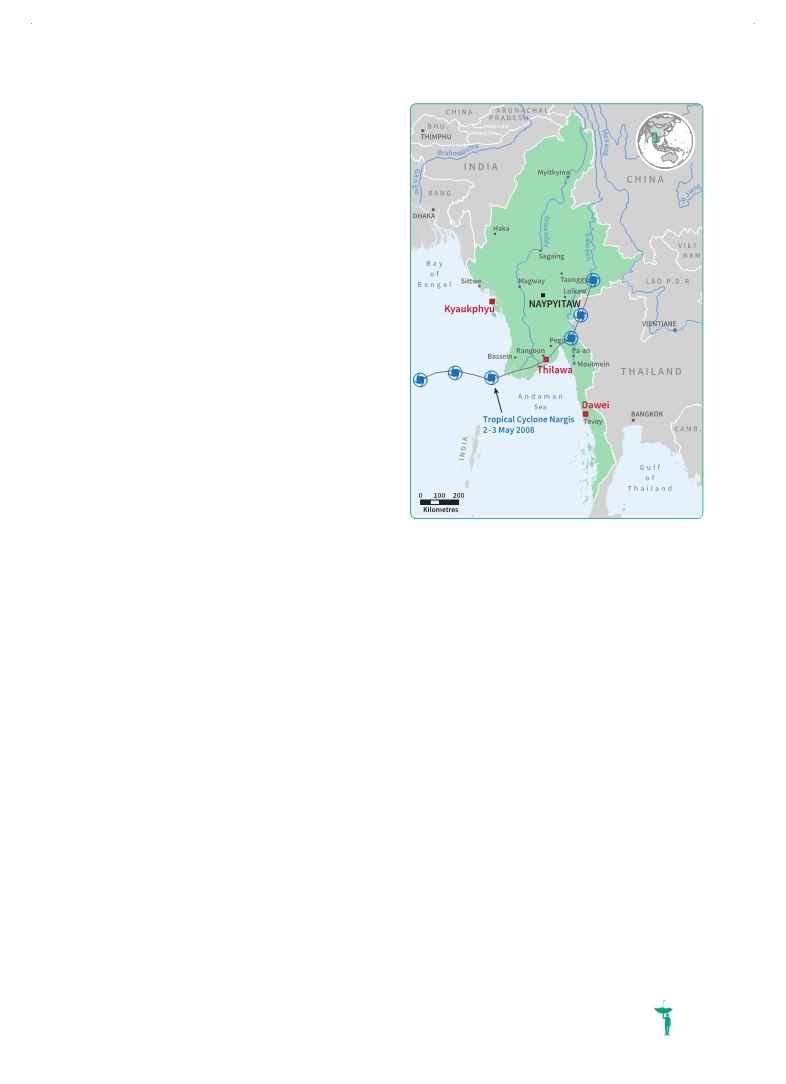 |
Global Assessment Report on Disaster Risk Reduction 2015
Making development sustainable: The future of disaster risk management |
 |
Global Assessment Report on Disaster Risk Reduction 2015
Making development sustainable: The future of disaster risk management |
|
|

211
that include a five-year tax holiday, 50 per cent income tax relief for five years on items exported overseas and on reinvested profits from overseas exports, a five-year exemption from customs duties on approved products, and the granting of 30-year land leases.
Myanmar has an AAL of US$2 billion, which is mainly associated with tropical cyclones, floods and earthquakes. In 2008, Tropical Cyclone Nargis caused major devastation in areas not far from where the Thilawa Special Economic Zone (Figure 10.8) is being planned as a home to textile, manufacturing and high-tech industries as well as a deep-sea port.
Although an environmental impact assessment was carried out as part of the planning of the SEZ, the potential disaster risks to the zone and the businesses that invest there are not explicitly described (Myanmar and Japan Consortium for Thilawa Special Economic Zone Development Project, 2013
Myanmar and Japan Consortium for Thilawa Special Economic Zone Development Project. 2013,Environmental Impact Assessment Report, September 2013.. . If governments, businesses and investors continue to ignore or to discount the consequences of further increasing the hazard exposure of the global economy, the consequences are likely to be more shocks of the kind that occurred in Japan and Thailand in 2011. For example, if the global economy were to grow at an average of 4 per cent per year for the next thirty years and the distribution of capital stock between hazard-exposed and non-hazard-exposed areas remains unchanged, by 2040 the volume of hazard-exposed capital stock and thus of intensive disaster risk would approximately double. If hazard and vulnerability also increase due to climate change and other risk drivers, then the risk could increase exponentially.
Most risk assessments still tend to be based on linear models with limited capacity to identify
and manage complex and interconnected risks (
 OECD, 2014a OECD, 2014a OECD (Organisation for Economic Co-operation and Development). 2014a,Interconnected, Interdependent Risks, Background Paper prepared for the 2015 Global Assessment Report on Disaster Risk Reduction. Geneva, Switzerland: UNISDR.. OECD (Organisation for Economic Co-operation and Development). 2014a,Interconnected, Interdependent Risks, Background Paper prepared for the 2015 Global Assessment Report on Disaster Risk Reduction. Geneva, Switzerland: UNISDR.. Click here to view this GAR paper. Shimizu, M. and A. Clark. 2014,Interconnected Risks, Cascading Disasters and Disaster Management Policy: A Gap Analysis, Input Paper for the 2015 Global Assessment Report on Disaster Risk Reduction. Geneva, Switzerland: UNISDR.. . While there is certainly momentum in the global private sector to begin assessing risk to supply chains when making investment decisions, it is still unclear whether these efforts will be sufficient to manage the risks from increasing exposure due to economic concentration and investment. And it is even less clear whether the countries competing to attract foreign direct investment will begin to use effective disaster
Figure 10.8 Location of the Thilawa Special Economic Zone
(Source: UNISDR with data from UNOCHA, 2013
UNOCHA (United Nations Office for the Coordination of Humanitarian Affairs). 2013,Myanmar: A Country Prone to a Range of Natural Disasters, Infographic from OCHA September 2013.. . |
 
Page 1Page 10Page 20Page 30Page 40Page 50Page 60Page 70Page 80Page 90Page 100Page 110Page 120Page 130Page 140Page 150Page 160Page 170Page 180Page 190Page 200Page 201Page 202Page 203Page 204Page 205Page 206Page 207Page 208Page 209Page 210Page 211Page 212->Page 213Page 214Page 215Page 216Page 217Page 218Page 219Page 220Page 221Page 222Page 223Page 224Page 225Page 230Page 240Page 250Page 260Page 270Page 280Page 290Page 300Page 310
|
|
 
|
 
|
